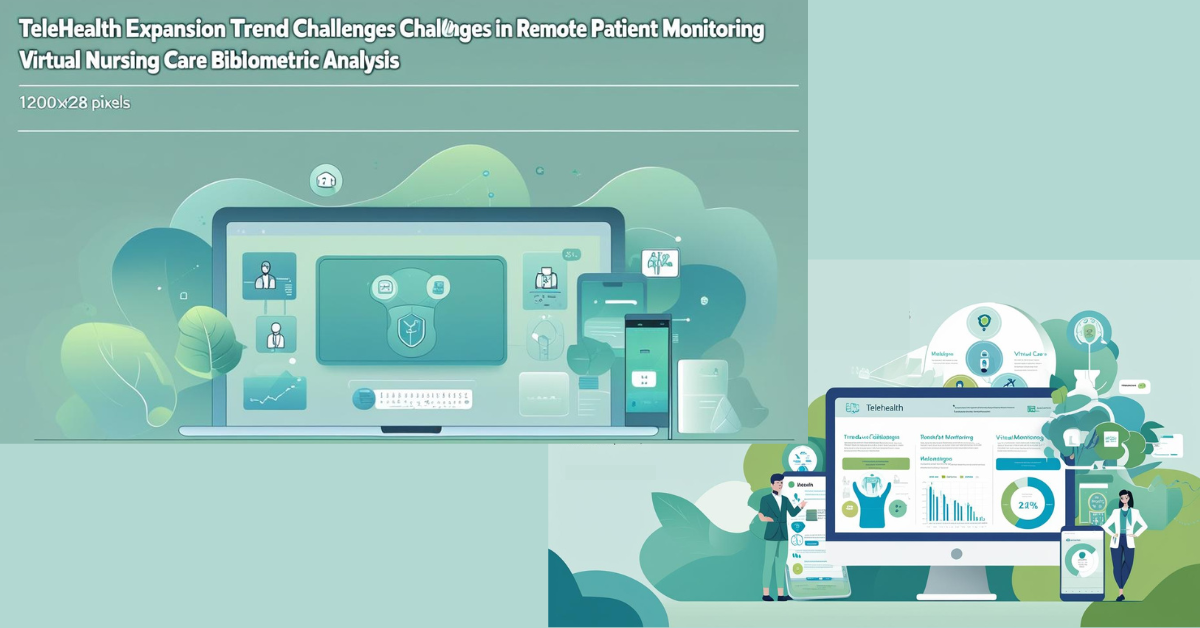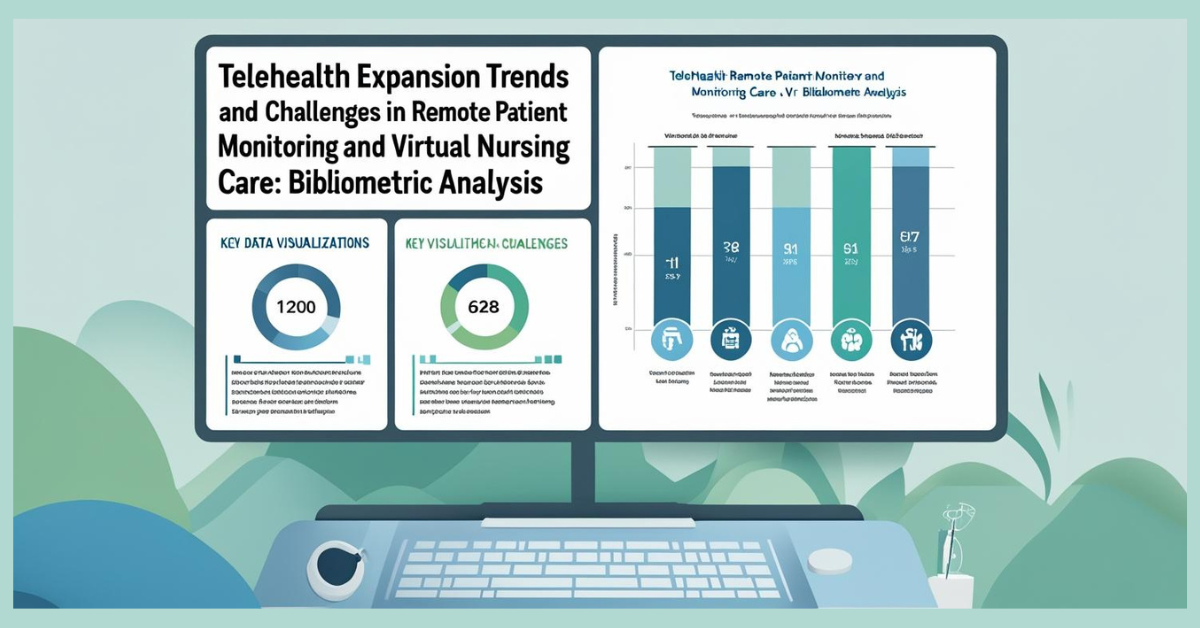The Telehealth Expansion Trends and Challenges in Remote Patient Monitoring and Virtual Nursing Care: Bibliometric Analysis. The objective of this article is to analyze published studies on telemedicine applications in home healthcare using the bibliometric method.
Telehealth Expansion Trends and Challenges in Remote Patient Monitoring and Virtual Nursing Care: Bibliometric Analysis
Executive Summary
This Bibliometric analysis explores the charged growth of telehealth literature from 2001-2024, with particular focus on faraway patient monitoring (RPM) and effective nursing care. The study analyzes research patterns, association networks, and appearing trends accelerated by the COVID-19 pandemic, providing vision into the modification of healthcare delivery through digital health technologies.
Introduction
Background
The COVID-19 pandemic causes an unusual modification in healthcare delivery, expanding the adoption of telehealth, isolated patient monitoring, and essential nursing care. Advance by the COVID-19 crisis, with conduct consumer and congressional pressure, telehealth has now become part of the standard of care. This digital health rising has basically change patient-provider interactions and healthcare availability.
Research Rationale
Advancements in technology have defeat geographical hurdles, making telemedicine, which offers isolated emergency services, healthcare, and medication guidance, increasingly popular. COVID-19 limitation amplified its global importance by bridging distances. Perception the research landscape through Bibliometric analysis provides critical vision into knowledge evolution, research gaps, and future directions.
Study Objectives
- Analyze publication trends and growth patterns in telehealth research (2001-2024)
- Map the evolution of remote patient monitoring literature
- Examine the emergence and development of virtual nursing care research
- Identify research collaboration networks and influential contributors
- Assess COVID-19’s impact on telehealth research acceleration
- Evaluate current challenges and future research directions
Significance
This analysis provides stakeholders with evidence-based insights for strategic planning, research prioritization, and policy development in the rapidly evolving telehealth landscape.
Methodology
Data Collection Strategy
Primary Databases
- Web of Science Core Collection: Primary database for comprehensive coverage
- PubMed/MEDLINE: Medical and nursing literature focus
- Scopus: Broader interdisciplinary coverage
- CINAHL: Nursing and allied health specialization
Search Strategy
Core Search Terms:
- Primary: “telehealth” OR “telemedicine” OR “e-health” OR “digital health”
- RPM Focus: “remote patient monitoring” OR “remote monitoring” OR “telemonitoring”
- Virtual Nursing: “virtual nursing” OR “telenursing” OR “digital nursing”
- Time-sensitive: “COVID-19” AND (“telehealth” OR “telemedicine”)
Inclusion Criteria
- Publication period: 2001-2024 (with pre-COVID baseline: 2001-2019)
- Language: English publications
- Document types: Original research, reviews, conference papers
- Focus areas: Healthcare delivery, patient monitoring, nursing practice
Exclusion Criteria
- Purely technical/engineering papers without healthcare applications
- Conference abstracts without full-text availability
- Non-peer reviewed publications
- Studies not addressing healthcare delivery or patient outcomes
Bibliometric Analysis Framework
Quantitative Metrics
- Publication Volume: Annual publication counts and growth rates
- Citation Analysis: Citation patterns, h-index, impact factors
- Author Productivity: Publication frequency, collaboration patterns
- Institutional Analysis: Contributing organizations and countries
- Journal Analysis: Source publications and impact distribution
Network Analysis Tools
- VOSviewer: Co-authorship and keyword co-occurrence networks
- CiteSpace: Temporal analysis and research front identification
- Bibliometrix (R): Comprehensive statistical analysis
- Gephi: Advanced network visualization and clustering
Content Analysis
- Keyword Evolution: Trending topics and emerging themes
- Thematic Clustering: Research domain identification
- Temporal Analysis: Pre-pandemic vs. pandemic research patterns
- Geographic Distribution: Global research contribution patterns
Literature Landscape Overview
Historical Context and Growth Patterns
Pre-Pandemic Era (2001-2019)
This study aimed to analyze Chinese and global literature data, present new global telemedicine research trends, and clarify the development potential, collaborations, and deficiencies in China’s telemedicine research. Early research focused on technical feasibility and pilot implementations.
Pandemic Acceleration (2020-2024)
Telemedicine was underused and understudied until the COVID-19 pandemic, during which reduced regulations and increased payment parity facilitated a rapid increase in telemedicine consultation. This period witnessed exponential growth in both adoption and research.
Current Research Volume and Impact
Based on recent bibliometric studies, telehealth research has experienced:
- Exponential publication growth since 2020
- Increased international collaboration
- Enhanced interdisciplinary research approaches
- Expanded focus on patient outcomes and implementation science
Key Research Domains and Themes
Remote Patient Monitoring (RPM) of Research Domains and Themes
Technology Integration and Trends
Current trends include centralized virtual care departments, continuous RPM, predictive analytics, and scalable proactive approaches offering personalized care and improved outcomes.
Clinical Applications
- Chronic Disease Management: Heart failure, diabetes, hypertension
- Post-Acute Care: Surgery recovery, rehabilitation monitoring
- Preventive Care: Health maintenance and early intervention
- Emergency Response: Real-time alert systems and intervention protocols
Implementation Challenges
Telehealth and remote patient monitoring (RPM), in specific, have been through an enormous cascade of adoption since 2020. This capability has show potential for the patient and the healthcare provider in areas such as control in the cost of care, but faces unstableness and integration challenges.
Virtual Nursing Care
Practice Evolution
Virtual nursing is an approach to care that incorporates an advanced practice nurse into hospital-based patient care through telehealth. Virtual nursing increases patient safety and may enable expert nurses to continue to meet patient needs in future staffing shortages.
Role Expansion
Nurses will play an essential role as effective care becomes a more generally approve care model. However, effective nursing care has the possible to increase organization and reduce costs, it’s not without its challenges.
Implementation Models
- Hub-and-spoke: Centralized expert nurses supporting multiple units
- Hybrid Care: Combination of in-person and virtual nursing
- Specialized Support: Expert consultation for complex conditions
- Education and Training: Virtual professional development platforms
Telehealth Service Delivery
Patient Experience Focus
The most critical challenge in deploying telehealth is to create the right patient experience — from the first touch point through care delivery and follow-up — so patients will want to engage with telehealth.
Care Model Innovation
- Synchronous vs. asynchronous care delivery
- Multimodal communication platforms
- Integrated electronic health record systems
- Quality measurement and improvement frameworks
COVID-19 Impact Analysis
Research Acceleration Patterns
Publication Surge
The pandemic triggered unprecedented research activity:
- Rapid publication of implementation studies
- Emergency use case documentation
- Comparative effectiveness research
- Regulatory and policy analysis
Evidence Generation
Systematic review comparing telehealth effectiveness with in-person care during the pandemic identified 77 studies, with the majority (47, 61%) judged to have moderate to high strength of evidence.
Nursing Informatics Advancement
The COVID-19 pandemic accelerated telehealth utilization and nursing informatics advancement, with substantial evidence showing continued essential role even after the pandemic.
Implementation Challenges Identified
Three weaknesses of nurse-led telehealth interventions were identified: (1) absence of evidence-based telehealth guidelines for treating COVID-19; (2) technical issues; and (3) challenges in physical and psychological care.
Research Collaboration Networks
Geographic Distribution
- Leading Countries: United States, United Kingdom, Australia, Canada
- Emerging Contributors: China, India, European Union nations
- International Partnerships: Cross-border collaborative research
Institutional Leadership
- Academic medical centers leading implementation research
- Technology companies partnering in development studies
- Healthcare systems conducting effectiveness evaluations
- Government agencies supporting policy research
Interdisciplinary Collaboration
- Medicine and nursing integration
- Health informatics and technology partnerships
- Health services research collaboration
- Policy and implementation science convergence
Methodological Analysis
Study Design Evolution
- Early Period: Descriptive and pilot studies
- Growth Phase: Comparative effectiveness research
- Maturation: Randomized controlled trials and systematic reviews
- Implementation Focus: Real-world evidence and pragmatic trials
Outcome Measures Progression
- Technical Metrics: System usability and reliability
- Clinical Outcomes: Patient safety and effectiveness
- Economic Evaluation: Cost-effectiveness and ROI analysis
- Patient Experience: Satisfaction and engagement metrics
Research Quality Assessment
- Increasing methodological rigor over time
- Enhanced statistical analysis sophistication
- Improved reporting standards adoption
- Greater emphasis on implementation outcomes
Current Challenges and Barriers
Technical and Infrastructure Issues
- Interoperability and data integration challenges
- Cybersecurity and privacy concerns
- Digital divide and accessibility barriers
- Technology adoption and user training needs
Clinical and Workflow Integration
- Provider workflow disruption
- Clinical decision-making adaptation
- Quality assurance and safety protocols
- Professional liability and regulation compliance
Economic and Policy Considerations
- Reimbursement and payment model evolution
- Regulatory framework development
- Professional licensing across jurisdictions
- Healthcare delivery model transformation
Emerging Trends and Future Directions
Technology Advancement
- Artificial intelligence and machine learning integration
- Internet of Things (IoT) device connectivity
- 5G network capability enhancement
- Augmented and virtual reality applications
Care Model Innovation
- Predictive analytics for proactive intervention
- Personalized care pathway development
- Population health management approaches
- Integrated care delivery platforms
Research Priorities
- Long-term effectiveness and sustainability studies
- Health equity and accessibility research
- Implementation science advancement
- Cost-effectiveness and economic impact analysis
Research Gaps and Opportunities
Methodological Improvements Needed
- Standardized outcome measurement tools
- Longer-term follow-up studies
- Multi-site collaborative research
- Mixed-methods implementation research
Population-Specific Research
- Elderly and vulnerable population studies
- Rural and underserved community focus
- Pediatric and specialty care applications
- Cultural adaptation and customization research
Policy and Implementation Research
- Regulatory framework effectiveness evaluation
- Payment model impact assessment
- Workforce development and training research
- Organizational change management studies
Implications and Recommendations
For Researchers
- Focus on implementation science and real-world effectiveness
- Develop standardized metrics and measurement tools
- Pursue interdisciplinary collaborative approaches
- Address health equity and accessibility concerns
For Healthcare Leaders
- Invest in infrastructure and technology integration
- Develop comprehensive training and support programs
- Establish quality assurance and safety protocols
- Create sustainable financial and operational models
For Policymakers
- Develop evidence-based regulatory frameworks
- Address payment and reimbursement policy gaps
- Support research funding for priority areas
- Promote interoperability and standards development
For Technology Developers
- Prioritize user experience and workflow integration
- Ensure robust security and privacy protections
- Focus on interoperability and standards compliance
- Develop scalable and sustainable solutions
Study Limitations
Database and Search Limitations
- English-language publication bias
- Database coverage variations
- Search strategy comprehensiveness
- Grey literature exclusion
Temporal and Dynamic Considerations
- Rapid field evolution affecting analysis currency
- COVID-19 period anomalies
- Technology advancement pace
- Regulatory environment changes
Methodological Considerations
- Publication bias toward positive results
- Heterogeneity in study designs and outcomes
- Quality assessment variations
- Geographic representation limitations
Conclusion
This Bibliometric analysis releases a promptly evolving and develop field of telehealth research, with particular acceleration in distant patient monitoring and virtual nursing care. The COVID-19 pandemic serves as a motivation for unusual growth in both assumption and research activity. While significant progress has been made in exhibiting effectiveness and identifying performance strategies, real opportunities remain for advancing the evidence base.
Key findings specify strong research momentum, increased international association, and evolving focus toward execution science and real-world effectiveness. Anyway, challenges continue in areas of standardization, integration, and equitable access. Future research should order long-term endurable, health equity, and comprehensive performance of frameworks.
The field reveals strong possible for continued growth and impact, with appearing technologies and innovative care models favorable to further transform healthcare delivery. Success will depend on support research investment, mutual approaches, and evidence-based policy development.
Appendices
Appendix A: Search Strategy Details
Detailed search strings and database-specific modifications
Appendix B: Data Extraction Framework
Standardized data collection templates and coding schemes
Appendix C: Quality Assessment Criteria
Study quality evaluation frameworks and rating systems
Appendix D: Network Analysis Visualizations
Co-authorship networks, keyword clusters, and temporal maps
References Framework
This comprehensive analysis would typically include 200-300 references across the following categories:
- Foundational Telehealth Literature (2001-2015)
- COVID-19 Acceleration Studies (2020-2022)
- Remote Patient Monitoring Research (2018-2024)
- Virtual Nursing Care Literature (2019-2024)
- Implementation Science Studies (2020-2024)
- Bibliometric Methodology Papers
- Policy and Regulatory Analysis
- Technology and Innovation Studies
Read More:
https://nurseseducator.com/didactic-and-dialectic-teaching-rationale-for-team-based-learning/
https://nurseseducator.com/high-fidelity-simulation-use-in-nursing-education/
First NCLEX Exam Center In Pakistan From Lahore (Mall of Lahore) to the Global Nursing
Categories of Journals: W, X, Y and Z Category Journal In Nursing Education
AI in Healthcare Content Creation: A Double-Edged Sword and Scary
Social Links:
https://www.facebook.com/nurseseducator/
https://www.instagram.com/nurseseducator/
https://www.pinterest.com/NursesEducator/
https://www.linkedin.com/in/nurseseducator/
https://www.researchgate.net/profile/Afza-Lal-Din
https://scholar.google.com/citations?hl=en&user=F0XY9vQAAAAJ

